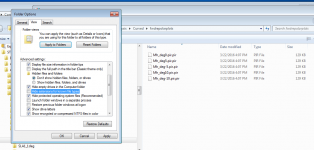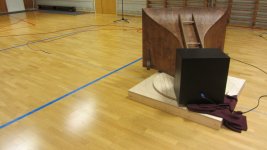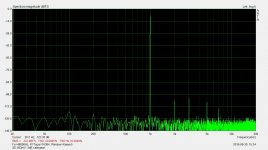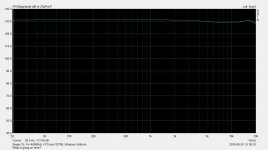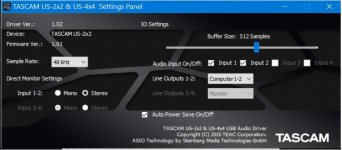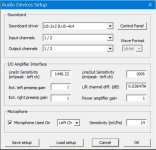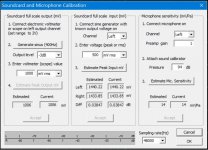Hi all.
For a while I have started to gather part for a home laboratory. I have some pc's some soundcards (@juli, emu 0404usb and of course the builtins 🙂 ). I have several usb external dacs and one adc from acko. Now for this session I will present what I found with all its errors in handling, connection and operating the ARTA suite plus everything you want to set your finger on. My wish is to get the levels right and checkable against other instruments (of which I don't have many that I trust).
So Basic setup to start with. I calibrated the outputs from my E-mu 0404 RMS against three medium trustable measurements - a Fluke 77, an UT61E and about 2VPP on my scope. Good enough? If not please point out that there is a flaw in my thinking.
I put in 1464mV(rms) for right and 1463mV(rms) for the left channel. At first I used them as input for the E-mu 0404 which of course clipped every time after I decreased it some 10's of mV. So for the input I took my old PM5109 and started from the bottom whilst pressing the "Estimate Peak Input mV" and found that my Inputs can handle about 0.96mV(rms) before clipping. So loopback with max output was a waste of time - it could never work without overdriving the inputs. I repeated the finding b lowering the output until it worked and got the same mv(rms) as with the external oscillator.
I think that the calibration is publicly taken easy on as it is the measurers responsibility to handle this task which makes it to woodoo where noone trusts their findings.
Now I know that there are quite many gurus out there that could point us into the right direction. Ivo made the suite and knows what is possible and others are more specialized from having the right cabling to what peaks are important.
The following are from my point of trust at least semi untrustable because I find them too good. Lets see if I can upload them or link somehow 😀
Regards
Now, there are my woes... Looking good but I can't get the peak to -3dB...
Calibration error?
I would very much apreciate handholding during calibration so I got that right so I can afterwards perform the same setup on other devices.
Regards
For a while I have started to gather part for a home laboratory. I have some pc's some soundcards (@juli, emu 0404usb and of course the builtins 🙂 ). I have several usb external dacs and one adc from acko. Now for this session I will present what I found with all its errors in handling, connection and operating the ARTA suite plus everything you want to set your finger on. My wish is to get the levels right and checkable against other instruments (of which I don't have many that I trust).
So Basic setup to start with. I calibrated the outputs from my E-mu 0404 RMS against three medium trustable measurements - a Fluke 77, an UT61E and about 2VPP on my scope. Good enough? If not please point out that there is a flaw in my thinking.
I put in 1464mV(rms) for right and 1463mV(rms) for the left channel. At first I used them as input for the E-mu 0404 which of course clipped every time after I decreased it some 10's of mV. So for the input I took my old PM5109 and started from the bottom whilst pressing the "Estimate Peak Input mV" and found that my Inputs can handle about 0.96mV(rms) before clipping. So loopback with max output was a waste of time - it could never work without overdriving the inputs. I repeated the finding b lowering the output until it worked and got the same mv(rms) as with the external oscillator.
I think that the calibration is publicly taken easy on as it is the measurers responsibility to handle this task which makes it to woodoo where noone trusts their findings.
Now I know that there are quite many gurus out there that could point us into the right direction. Ivo made the suite and knows what is possible and others are more specialized from having the right cabling to what peaks are important.
The following are from my point of trust at least semi untrustable because I find them too good. Lets see if I can upload them or link somehow 😀
Regards
An externally hosted image should be here but it was not working when we last tested it.
An externally hosted image should be here but it was not working when we last tested it.
An externally hosted image should be here but it was not working when we last tested it.
An externally hosted image should be here but it was not working when we last tested it.
An externally hosted image should be here but it was not working when we last tested it.
Now, there are my woes... Looking good but I can't get the peak to -3dB...
Calibration error?
I would very much apreciate handholding during calibration so I got that right so I can afterwards perform the same setup on other devices.
Regards
Last edited:
Rather than editing I'll add that the first pic was with loopback from the E-mu and the rest are inputs from the external oscillator. As I haven't calibrated with that one makes it impossible to reach -3dB. Guessing again which makes the readings unsure...
Hi Turbon,
let me explain the problem of calibration.
Almost all soundcards have no calibrated volume controls, especially those that has hardware potentiometers. It means that we can calibrate voltage readings (dBV) or ratio to full scale sensitivity (dBFS) of soundcards only for one fixed position of potentiometer.
And this makes process of calibration complicated.
ARTA allows calibration for that fixed position of volume controls.
Input calibration value is voltage that is needed for exciting full input range.
Output signal level is not important, but we can use soundcard output signal to make calibration of input.
How we do that?
We first measure voltage of signal that ARTA generate by external voltmeter. Before that measurement it is important that we monitor spectrum of generated sine signal in loopback connection and set output level that do no push input into the clipping. A reasonable value is level that is 3dB (or more) bellow clipping (0dB).
In calibration of both input channel, in loopback connection, we use level that was measured with electronic voltmeter. We enter that value in edit box and ARTA makes further calculation of input voltage sensitivity (voltage that will fully excite input for fixed level of volume control or potentiometer).
After we make calibration we are able to monitor signal that has voltage lower than input sensitivity. The scalling of spectrum can be chosen to show dBFS, dBV of power spectrum density (dBV/sqrt(Hz)).
Ivo
let me explain the problem of calibration.
Almost all soundcards have no calibrated volume controls, especially those that has hardware potentiometers. It means that we can calibrate voltage readings (dBV) or ratio to full scale sensitivity (dBFS) of soundcards only for one fixed position of potentiometer.
And this makes process of calibration complicated.
ARTA allows calibration for that fixed position of volume controls.
Input calibration value is voltage that is needed for exciting full input range.
Output signal level is not important, but we can use soundcard output signal to make calibration of input.
How we do that?
We first measure voltage of signal that ARTA generate by external voltmeter. Before that measurement it is important that we monitor spectrum of generated sine signal in loopback connection and set output level that do no push input into the clipping. A reasonable value is level that is 3dB (or more) bellow clipping (0dB).
In calibration of both input channel, in loopback connection, we use level that was measured with electronic voltmeter. We enter that value in edit box and ARTA makes further calculation of input voltage sensitivity (voltage that will fully excite input for fixed level of volume control or potentiometer).
After we make calibration we are able to monitor signal that has voltage lower than input sensitivity. The scalling of spectrum can be chosen to show dBFS, dBV of power spectrum density (dBV/sqrt(Hz)).
Ivo
Thank you Ivo for your explanation and for the Arta suite, very good 🙂.
What you write makes sense and is pretty much how I understod the process and function.
My only problem is that I find the values in the measurements to be remarkably good. Almost too good to be true 😉.
Btw. My max input is 96mV(rms) and nothing else with controls set to 0 amplification on the E-mu.
Regards
What you write makes sense and is pretty much how I understod the process and function.
My only problem is that I find the values in the measurements to be remarkably good. Almost too good to be true 😉.
Btw. My max input is 96mV(rms) and nothing else with controls set to 0 amplification on the E-mu.
Regards
Hi guys. I've done some polar measuring but right now I can't get ARTA to create polar plots. It worked last time I tried, I can't see what's wrong my with my name files.
Does anyone see anything wrong with mye files? I tried adding + as well, but made no difference. Still get the error message. Need some other eyes!
Does anyone see anything wrong with mye files? I tried adding + as well, but made no difference. Still get the error message. Need some other eyes!
Attachments
Hi guys. I've done some polar measuring but right now I can't get ARTA to create polar plots. It worked last time I tried, I can't see what's wrong my with my name files.
Does anyone see anything wrong with mye files? I tried adding + as well, but made no difference. Still get the error message. Need some other eyes!
Have a try on adding “+” to the positive angle
All the best
I don't see anything wrong with the files names.
I tried renaming some of my *.pir files with your file names and they worked just fine.
Can you post a *.zip file containing the 7 *.pir files to see if others get the same error message when selecting them?
I tried renaming some of my *.pir files with your file names and they worked just fine.
Can you post a *.zip file containing the 7 *.pir files to see if others get the same error message when selecting them?
I sent Ivo some of my files and he was able to create a polar with them. Using the exact same files I sent him and trying on two different computers, I still get the error message. 😕
Also tried to uninstall ARTA and reinstall it on one computer but with no success. This is really weird. Could it be a conflict with another program?
I've attached the files.
Also tried to uninstall ARTA and reinstall it on one computer but with no success. This is really weird. Could it be a conflict with another program?
I've attached the files.
Attachments
Ok. I get the same error as you do.
Looking at the pic I attached you can see that when I turned off file browser option to hide file extensions, you can see that the files names have an extra ".pir" in the file name. I'm guessing you must have the "hide file extension" option selected so the *.pir extension wasn't showing up so you added another one in by hand.
Removing the extra ".pir" and the files work fine. 🙂
Looking at the pic I attached you can see that when I turned off file browser option to hide file extensions, you can see that the files names have an extra ".pir" in the file name. I'm guessing you must have the "hide file extension" option selected so the *.pir extension wasn't showing up so you added another one in by hand.
Removing the extra ".pir" and the files work fine. 🙂
Attachments
Glad to hear that solved your problem.
Once again Microsoft trying to "help" out by hiding things they think you don't need to see.
Nice measurement space!!!



Once again Microsoft trying to "help" out by hiding things they think you don't need to see.
Nice measurement space!!!



Dual channel measurement
I need to record/measure two microphones at the same time. Left ear and Right ear.
Is this possible in ARTA? I know there is a dual mode, but does that use one channel as a reference or as another source?
Any info is welcome. Thanks!
I need to record/measure two microphones at the same time. Left ear and Right ear.
Is this possible in ARTA? I know there is a dual mode, but does that use one channel as a reference or as another source?
Any info is welcome. Thanks!
I need to record/measure two microphones at the same time. Left ear and Right ear.
Is this possible in ARTA? I know there is a dual mode, but does that use one channel as a reference or as another source?
Current version of ARTA is single channel system for SPL & FR measurements, although dual channel mode uses second channel as reference.
In ARTA version 2.0 it will be possible to measure SPL of two channels, but that version will be published in more that one year.
Best,
Ivo
ARTA MeasuringBox + soundcard with Mic Pre built-in?
Hi, I am in the process of putting together an ARTA setup, and was planning to use Tascam US-2x2 or Scarlett 2i2 to start with. Both have build-in microphone preamp, which I am hoping to be able to use. I found the above quote regarding calibration routine for this type of setup, so that helps, but I can't figure out how (and if) this affects the design or use of the MeasuringBox (As per ARTA Application note).
Does anyone know if I should just build the standard MeasuringBox, or if it should be modified somehow, to account for the use of a Soundcard integrated mic pre amp?
- I can't quite figure it out, even after studying the documentation extensively - much confusion to be had...
(...)
Originally Posted by soundrex
"It would also be enlightening to know the procedure to calibrate a usb sound card like Focusrite Scarlet 2i2 where one input is used for a calibrated mic (No separate mic pre used and so gain is unknown) and the other one for reference"
Focusrite Scarlet 2i2 is relatively cheap, it has stable driver and it is very good for acoustical measurements. It has inputs/outputs typical for all professional sound cards:
a) Balanced outputs
b) Unbalanced headphone outputs
c) Balanced microphone inputs
d) Unbalanced line/instrumentation inputs
The trick in calibration is that you would calibrate front balanced mic. input connected to rear balanced output, and reference line input connected to headphone output. In balanced XLR connector signal is measured between pin 2 and 3.
For impedance measurements you can use headphone output and two line inputs with reference resistor 47-100 ohms (using circuit that is shown in figure 3.1 in Limp user manual).
Best,
Ivo
Hi, I am in the process of putting together an ARTA setup, and was planning to use Tascam US-2x2 or Scarlett 2i2 to start with. Both have build-in microphone preamp, which I am hoping to be able to use. I found the above quote regarding calibration routine for this type of setup, so that helps, but I can't figure out how (and if) this affects the design or use of the MeasuringBox (As per ARTA Application note).
Does anyone know if I should just build the standard MeasuringBox, or if it should be modified somehow, to account for the use of a Soundcard integrated mic pre amp?
- I can't quite figure it out, even after studying the documentation extensively - much confusion to be had...

Tascam US-2x2 with ARTA
Hello, I am still hoping for an answer to above post, but else I will probably build the standard ARTA box to start with, and see how that works out...
Meanwhile, I now have a Tascam US-2x2 and a microphone, and have been trying to get it all set up and calibrated 🙂
At the moment I have the Tascam output calibrated with the Line Out volume set at 12 o'clock, which gives a signal of 500mVrms. This gives the lowest THD in ARTA Spectrum Magnitude self testing. I am using single ended jack cables (TRS plug with no-contact on Ring), but have also tried with balanced cable, which gave about the same results, but with slightly lower THD due to 2nd harmonics cancelling out. So far so good.
Next step is the Frequency response self test (loop back on both channels), and here the problems begin: The FR plot looks very strange to me, not anything like I have seen posted around here. I get the same results with both FR1 and FR2. Level just over 130dB, pretty flat but with some variance towards the high end of the spectrum. I have tried a bunch of different settings, but to no avail. I would really appreciate some help here 😕
Please see attached screenshots of Spectrum, FR and my current settings for Arta and Asio.
Hello, I am still hoping for an answer to above post, but else I will probably build the standard ARTA box to start with, and see how that works out...
Meanwhile, I now have a Tascam US-2x2 and a microphone, and have been trying to get it all set up and calibrated 🙂
At the moment I have the Tascam output calibrated with the Line Out volume set at 12 o'clock, which gives a signal of 500mVrms. This gives the lowest THD in ARTA Spectrum Magnitude self testing. I am using single ended jack cables (TRS plug with no-contact on Ring), but have also tried with balanced cable, which gave about the same results, but with slightly lower THD due to 2nd harmonics cancelling out. So far so good.
Next step is the Frequency response self test (loop back on both channels), and here the problems begin: The FR plot looks very strange to me, not anything like I have seen posted around here. I get the same results with both FR1 and FR2. Level just over 130dB, pretty flat but with some variance towards the high end of the spectrum. I have tried a bunch of different settings, but to no avail. I would really appreciate some help here 😕
Please see attached screenshots of Spectrum, FR and my current settings for Arta and Asio.



